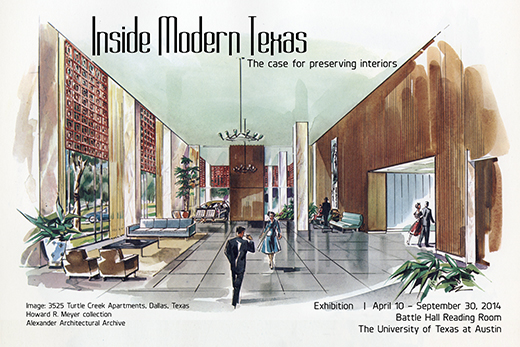A new exhibit, “Inside Modern Texas: The Case for Preserving Interiors,” opens April 10th at 6 pm at The University of Texas at Austin’s Architecture & Planning Library.
“Inside Modern Texas” offers insight on interior design during the period 1945 to 1975, touching upon the development of the profession and the issues faced today in historic preservation. Texas interiors from this period serve as case studies to illustrate emerging ideas in design and practice.
The exhibit includes photographs, original drawings and printed materials from the Alexander Architectural Archive and the Architecture and Planning Library. Featured architects and interior designers include George L. Dahl, Harwell Hamilton Harris, Karl Kamrath, Howard R. Meyer and John Astin Perkins.
Emily Ardoin, a graduate student in the School of Architecture’s Historic Preservation program, curated the exhibit through a new program developed with the School of Architecture. Head Librarian Beth Dodd hopes that collaborations such as this will provide graduate students with more opportunities to use the archives to produce new scholarship.
“We are always looking for ways to enhance the student experience, and curating an exhibit is an incredibly rigorous process that demands thorough research, careful selection and interpretation of materials, and exhibit design,” says Dodd. “The endowment created by the late Professor Blake Alexander now enables us to offer our students this funded internship.”
Mid-twentieth-century buildings are gaining widespread acceptance as candidates for historic preservation, but few retain their original modern interiors. Because they are so closely connected to human activity, interiors can be especially important conveyors of historic significance, but they are highly vulnerable to changing tastes and functional requirements. The perceived impermanent nature of interior design components, and historic preservation legislation which often focuses on building exteriors, further complicates preservation efforts.
Repositories such as the Alexander Architectural Archive provide opportunities to study the history of design. “Because interiors are so vulnerable to change, teaching and research rely on libraries and archives for historic documentation,” notes Dodd. “In this first exhibit, Emily had to dig deep to discover material in the collections of architects who were only starting to recognize interior design as a distinct profession.”
The exhibition will be on display in the Architecture and Planning Library reading room in Battle Hall through September, and is free and open to the public. The opening reception will be held April 10 at 6:00 p.m. in conjunction with the Society of Architectural Historians 2014 Annual Conference.

